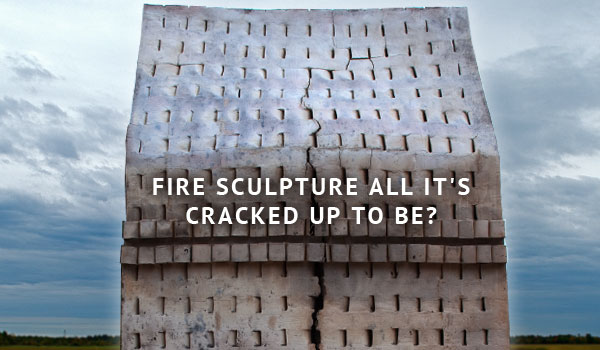Fire Sculpture All It’s Cracked Up to Be?
Story by Lindsey Chester. Photo by Hal Goodtree. Ms. Chester is a member of the Town’s Parks & Rec Advisory Board.
Cary, NC- The Town of Cary recently sponsored a unique art event, titled Monumental Fire by Nina Hole that was created on-site and publicly revealed on November 2. Now that the dust has literally settled, we have heard some feedback from the public and wanted to share.
Cracked
At a Parks & Rec meeting, I heard stories about a crack in the sculpture. Another friend described a large crack and a roof that was caved in. This sounded serious, so I decided to head over to the Performance Green on Academy Street, opposite the Cary Arts Center, where the sculpture resides.
What I found is pictured above. The crack is present, but not life-threatening.
Part of the Art
Lyman Collins, Cultural Arts Manager for the Town, had this to say about the nature of this type of large-scale public art:
The crack is a natural part of the process when clay is fired at very high temperatures and then exposed to much lower temperatures. There is no way to predict where or how such cracks may appear but it is a part of the piece itself. Artist Nina Hole inspected the piece prior to her departure and she was not alarmed nor concerned. There is no evidence that it has affected the structural integrity of the piece and just serves to give it additional character.
Lyman went on to add:
I have gone on Nina’s website and looked and her other pieces there and it is easy to see that cracks such as this happen in virtually all of her pieces. In no way is it a flaw but rather part of the work itself.
Something to Talk About
Any public art piece should tests the limits of the public. What only 70 years ago was considered crazy and avante guard is now readily accepted. Think Andy Warhol and Picasso didn’t hear any flack about their creations?
Here’s a comment I received on my own Facebook page about the piece:
I learned that the ‘job’ of art is to make the viewer think, to react, to have some response. If your response is ‘yuck’ and we talk about it, then actually the art is doing a good job.
The town’s official position is that the piece met its goals. It created a wonderful experience during the building and the night of the reveal – which was enhanced with a concert and outdoor festival atmosphere open to all for free.
Lyman’s closing comments reflect some of my own feelings about public art:
It is a healthy community that has conversation and dialogue around a piece of public art and that is what we are seeing here.
What Do You Think?
What do you think? The Town is taking suggestions about presentation and ideas for enhancement. Have an idea, please post below in our comments section, just mind our comments policy and be respectful.




I suggest moving the piece to a location in Cary that better reflects the sculpture’s appearance, construction, and character. A site at the end of North Dixon Avenue would be the most appropriate place in Cary for this piece.
If the best we can do is come up with ideas for “improving” the artist’s creation, it should be painfully obvious to all that this is not something that should be in the middle of our Town.
Other than you, of course, who suggested moving it?
I’m sorry, I misread, its so early. Actually that is a really good point about having to take suggestions on “improving” it. It was awe-inspiring when it was on fire. Too bad it can’t be a pillar of fire every night.
I like the suet idea and adding color. Maybe map off squares or rectangles and let local artists do their magic on their space. Kind of like the wolves that were all over Raleigh.
I looked at the website for the artist before it was constructed here, and was a bit disappointed in the results. Hoped that something better would happen in Cary. The reveal was interesting and attracted a good crowd. It sort of reminds me of the remnants from a war zone — I am disappointed. I think there needs to be an effort to make the whole thing more attractive. Maybe plant kudzu next to it — just kidding.. but some sort of fitting vegetation is called for. I am sure that the artists in Cary can make some improvements.
I think it would look good with some good old organic COLOR. Flowers, air plants, vines, etc. Certain ones attract butterflies. I think the suet is a good idea, too, but plants could take care of bird-feeding as well, and the base lamp or something to make it glow out the holes on the inside would be awesome from dusk till dawn.
I don’t see why we couldn’t have all those ideas and really have it come to life. It has the potential to be a practical centerpiece. Get the master gardeners of Cary involved.
The sculpture, in a flat, bare field, doesn’t have much obvious context. Other public sculptures, in Cary and elsewhere, are installed where they work with the surroundings. (It’s exactly why I photograph people in parks instead of home.) You couldn’t build this in the Page Walker garden or Town Hall lawn. This sculpture had to be built where the surroundings will grow around it. And they will.
Having photographed it being made and fired and since for the artist, I’ve spent some time thinking about it. Technically, rolling that much clay, outdoors with big temperature and humidity swings and firing it with wood, shouldn’t work. If “Extreme Ceramics” was a reality show, we saw it. It was made with water, sand, clay and wood, ancient materials used in a modern process. Given enough time and labor, it probably could’ve been made from the field it stands in, risen up in place, like the life of a Town. Right now, there isn’t much reason to walk about the flat, bare field. Except when you get close to the sculpture and put your hand on it and understand it’s permanence and durability and imperfection, just like our human character. A thoughtful landscape architect will understand and it will drive the nature of the design.
While I understand the good intentions, I think it not a good idea to turn it into a giant bird feeder. If the birds find it, like a bole or an eave or an open Warehouse Club door, so be it. They’ve been doing that for a very long time.
Even small ceramics have failures. One never gets 100% even in commercial operations. The larger the size and the less control over cooling are also factors. For a large heavy structure, the base it sits upon is also important. Concrete would probably not be practical as it would stress from the heat. Probably a base of crush and run used for roads before paving would work and would need to be 6-18 inches thick and well packed before putting the ceramic structure on top. But she is an artist and probably not a structural engineer. And even engineers are fallible.
I drive past the sculpture almost daily, avidly followed the construction process and thoroughly enjoyed the reveal evening. What I feel now is a bit of a letdown. It is not that it isn’t interesting, but that the piece feels unfinished, like once the crowd left and the wood was picked up that was it. I hope that there is more to come. Interior lights and a nice base might be a nice start.
Our President just did a traditional pardon of a bird, about an hour ago.
I feel as citizens we have a responsibility for a healthy community of wild birds in Cary as well.
Let’s consider citizen-volunteer “stuffing” the sculpture’s intentional openings with bird suet, during our approaching cold weather. This is both respectful of our habitat as well as increasing traffic to the actual sculpture.
Sunflower seeds will no doubt be appreciated by the many mated pairs of State Birds in the area.
Bird dropping discoloration can easily be power-washed in the Spring.